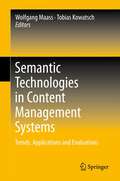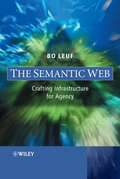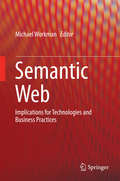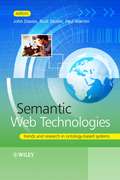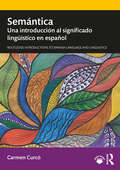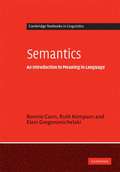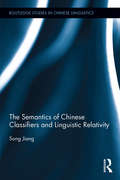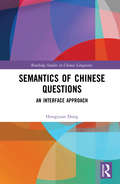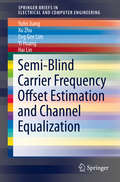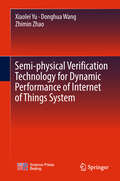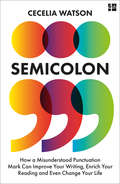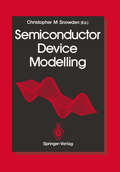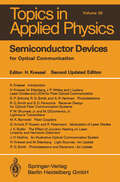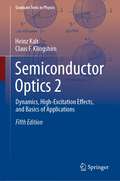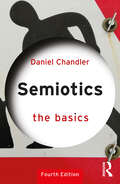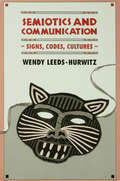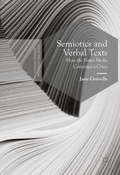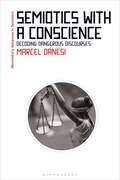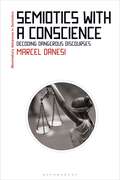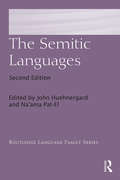- Table View
- List View
Semantic Technologies in Content Management Systems: Trends, Applications and Evaluations
by Wolfgang Maass Tobias KowatschContent Management Systems (CMSs) are used in almost every industry by millions of end-user organizations. In contrast to the 90s, they are no longer used as isolated applications in one organization but they support critical core operations in business ecosystems. Content management today is more interactive and more integrative: interactive because end-users are increasingly content creators themselves and integrative because content elements can be embedded into various other applications. The authors of this book investigate how Semantic Technologies can increase interactivity and integration capabilities of CMSs and discuss their business value to millions of end-user organizations. This book has therefore the objective, to reflect existing applications as well as to discuss and present new applications for CMSs that use Semantic Technologies. An evaluation of 27 CMSs concludes this book and provides a basis for IT executives that plan to adopt or replace a CMS in the near future.
The Semantic Web: Crafting Infrastructure for Agency
by Bo LeufThe Semantic Web is an idea of World Wide Web inventor Tim Berners-Lee that the Web as a whole can be made more intelligent and perhaps even intuitive about how to serve a users needs. Although search engines index much of the Web's content, they have little ability to select the pages that a user really wants or needs. Berners-Lee foresees a number of ways in which developers and authors, singly or in collaborations, can use self-descriptions and other techniques so that the context-understanding programs can selectively find what users want. The Semantic Web: Crafting Infrastructure for Agency presents a more holistic view of the current state of development and deployment. This a comprehensive reference to the rapidly developing technologies, which are enabling more intelligent and automated transactions over the internet, and a visionary overview of the implications of deploying such a layer of infrastructure. A through examination of the Semantic Web, including the following topics: web information management, languages and protocols, application and tools, and collaboration and agency. A unique volume of practical information, in-depth analysis, conceptual overviews and contextual material from professionals in the field. Features appendices of technical terms and glossary, Semantic Web resources, intellectual property issues and lists of elements. This is essential reading for engineers, web developers and industry professionals wishing to enhance their knowledge of recent developments. Management staff, lecturers. postgraduate and undergraduate students will also find this book appealing.
Semantic Web: Implications for Technologies and Business Practices
by Michael WorkmanThis book examines recent developments in semantic systems that can respond to situations and environments and events. The contributors to this book cover how to design, implement and utilize disruptive technologies. The editor discusses the two fundamental sets of disruptive technologies: the development of semantic technologies including description logics, ontologies and agent frameworks; and the development of semantic information rendering and graphical forms of displays of high-density time-sensitive data to improve situational awareness. Beyond practical illustrations of emerging technologies, the editor proposes to utilize an incremental development method called knowledge scaffolding –a proven educational psychology technique for learning a subject matter thoroughly. The goal of this book is to help readers learn about managing information resources, from the ground up and reinforcing the learning as they read on.
Semantic Web Technologies: Trends and Research in Ontology-based Systems
by John Davies Rudi Studer Paul WarrenThe Semantic Web combines the descriptive languages RDF (Resource Description Framework) and OWL (Web Ontology Language), with the data-centric, customizable XML (eXtensible Mark-up Language) to provide descriptions of the content of Web documents. These machine-interpretable descriptions allow more intelligent software systems to be written, automating the analysis and exploitation of web-based information. Software agents will be able to create automatically new services from already published services, with potentially huge implications for models of e-Business. Semantic Web Technologies provides a comprehensive overview of key semantic knowledge technologies and research. The authors explain (semi-)automatic ontology generation and metadata extraction in depth, along with ontology management and mediation. Further chapters examine how Semantic Web technology is being applied in knowledge management (“Semantic Information Access”) and in the next generation of Web services. Semantic Web Technologies: Provides a comprehensive exposition of the state-of-the art in Semantic Web research and key technologies. Explains the use of ontologies and metadata to achieve machine-interpretability. Describes methods for ontology learning and metadata generation. Discusses ontology management and evolution, covering ontology change detection and propagation, ontology dependency and mediation. Illustrates the theoretical concepts with three case studies on industrial applications in digital libraries, the legal sector and the telecommunication industry. Graduate and advanced undergraduate students, academic and industrial researchers in the field will all find Semantic Web Technologies an essential guide to the technologies of the Semantic Web.
Semántica: Una introducción al significado lingüístico en español
by Carmen CurcóSemántica: Una introducción al significado lingüístico en español es una introducción integral al estudio de la semántica con un enfoque especial en la lengua española. Sin asumir conocimientos lingüísticos previos, el libro conduce al lector por los principales temas del estudio del significado, logrando un equilibrio entre la teoría y la práctica. Los temas nocionales y las discusiones conceptuales se entrelazan con el desarrollo de herramientas analíticas. Las explicaciones se apoyan en abundantes ejemplos que ilustran los puntos tratados. Cada capítulo proporciona ejercicios y sugerencias para lecturas e investigaciones adicionales con el fin de guiar a los estudiantes de español en las complejidades de la semántica léxica y composicional. Escrito íntegramente en español en un estilo claro y atractivo, el libro es ideal para estudiantes avanzados de pregrado y posgrado de español y lingüística hispánica. Semántica: Una introducción al significado lingüístico en español is a comprehensive introduction to the study of semantics with a special focus on Spanish. Without assuming prior linguistic knowledge, the book leads the reader through the main topics in the study of meaning, striking a balance between theory and practice. In a clear and engaging style, notional issues and conceptual discussions are intertwined with the development of analytical tools. Explanations are supported by plentiful examples to reinforce each new point. Exercises and suggestions for further reading and research are provided throughout to guide students of Spanish seamlessly into the complexities of lexical and compositional semantics. Written entirely in Spanish, the book is ideal for advanced undergraduate and graduate students of Spanish and Spanish linguistics.
Semántica: Una introducción al significado lingüístico en español
by Carmen CurcóSemántica: Una introducción al significado lingüístico en español es una introducción integral al estudio de la semántica con un enfoque especial en la lengua española. Sin asumir conocimientos lingüísticos previos, el libro conduce al lector por los principales temas del estudio del significado, logrando un equilibrio entre la teoría y la práctica. Los temas nocionales y las discusiones conceptuales se entrelazan con el desarrollo de herramientas analíticas. Las explicaciones se apoyan en abundantes ejemplos que ilustran los puntos tratados. Cada capítulo proporciona ejercicios y sugerencias para lecturas e investigaciones adicionales con el fin de guiar a los estudiantes de español en las complejidades de la semántica léxica y composicional. Escrito íntegramente en español en un estilo claro y atractivo, el libro es ideal para estudiantes avanzados de pregrado y posgrado de español y lingüística hispánica. Semántica: Una introducción al significado lingüístico en español is a comprehensive introduction to the study of semantics with a special focus on Spanish. Without assuming prior linguistic knowledge, the book leads the reader through the main topics in the study of meaning, striking a balance between theory and practice. In a clear and engaging style, notional issues and conceptual discussions are intertwined with the development of analytical tools. Explanations are supported by plentiful examples to reinforce each new point. Exercises and suggestions for further reading and research are provided throughout to guide students of Spanish seamlessly into the complexities of lexical and compositional semantics. Written entirely in Spanish, the book is ideal for advanced undergraduate and graduate students of Spanish and Spanish linguistics.
Semantics: An Introduction to Meaning in Language (PDF)
by Ronnie Cann Ruth Kempson Eleni GregoromichelakiThe study of meaning in language has developed dramatically over the last fifty years. Semantics is distinctive as it not only presents a general introduction to the topic, including the most recent developments, but it also provides a unique perspective for addressing current issues. It opens by introducing readers to the study of logic (natural deduction) as the background against which developments have taken place. This demonstrates the link between semantics and the study of reasoning and how this view can provide new solutions to the puzzles that have plagued the approaches presented in other textbooks. The major subject areas of semantics are discussed, including quantification, anaphora and discourse, tense and aspect, ellipsis and context and word meaning. The book also presents state-of-the-art research in topics at the forefront of semantics.
The Semantics of Chinese Classifiers and Linguistic Relativity (Routledge Studies in Chinese Linguistics)
by Song JiangThe Semantics of Chinese Classifiers and Linguistic Relativity focuses on the semantic structure of Chinese classifiers under the cognitive linguistics framework, and the implications thereof on linguistic relativity and language acquisition. It examines the semantic correlation between a given classifier and its associated nouns. Nouns in Chinese, which are assigned specific classifiers according to their selected characteristics, reflect the process of human categorization. The concrete categories formed by the relationship between nouns and classifiers may serve to explain the conceptual structure of the Chinese language and certain underlying aspects of culture and human cognition. Song Jiang is Assistant Professor of Chinese for the Department of East Asian Languages and Literatures at university of Hawai‘i at Mānoa.
The Semantics of Chinese Classifiers and Linguistic Relativity (Routledge Studies in Chinese Linguistics)
by Song JiangThe Semantics of Chinese Classifiers and Linguistic Relativity focuses on the semantic structure of Chinese classifiers under the cognitive linguistics framework, and the implications thereof on linguistic relativity and language acquisition. It examines the semantic correlation between a given classifier and its associated nouns. Nouns in Chinese, which are assigned specific classifiers according to their selected characteristics, reflect the process of human categorization. The concrete categories formed by the relationship between nouns and classifiers may serve to explain the conceptual structure of the Chinese language and certain underlying aspects of culture and human cognition. Song Jiang is Assistant Professor of Chinese for the Department of East Asian Languages and Literatures at university of Hawai‘i at Mānoa.
Semantics of Chinese Questions: An Interface Approach (Routledge Studies in Chinese Linguistics)
by Hongyuan DongSemantics of Chinese Questions is the first major study of Chinese questions, especially wh-questions, within the framework of Alternative Semantics. It takes an interface approach to study the syntax, semantics, and phonology of questions and proposes a phonological scope-marking strategy in Chinese questions, based upon experimental data. It also incorporates historical linguistic data regarding the grammaticalization of sentence-final particles such as –ne and –ma to study the formal diachronic semantics of questions. Primarily suitable for scholars in the field of Chinese linguistics, this book makes new theoretical contributions to the study of questions.
Semantics of Chinese Questions: An Interface Approach (Routledge Studies in Chinese Linguistics)
by Hongyuan DongSemantics of Chinese Questions is the first major study of Chinese questions, especially wh-questions, within the framework of Alternative Semantics. It takes an interface approach to study the syntax, semantics, and phonology of questions and proposes a phonological scope-marking strategy in Chinese questions, based upon experimental data. It also incorporates historical linguistic data regarding the grammaticalization of sentence-final particles such as –ne and –ma to study the formal diachronic semantics of questions. Primarily suitable for scholars in the field of Chinese linguistics, this book makes new theoretical contributions to the study of questions.
Semi-Blind Carrier Frequency Offset Estimation and Channel Equalization (SpringerBriefs in Electrical and Computer Engineering #0)
by Yufei Jiang Xu Zhu Eng Gee Lim Yi Huang Hai LinThis SpringerBrief investigates the performance of semi-blind independent component analysis (ICA) based equalization and carrier frequency offset estimation approaches (CFO) for a number of orthogonal frequency division multiplexing (OFDM) based wireless communication systems. It provides a comprehensive overview of the challenges of channel equalization and frequency synchronization for different wireless systems. The authors present the wireless communication channel and system models. Key existing CFO estimation methods are reviewed, along with a number of the training based and non-training based (blind) channel estimation methods. This is followed by a study of ICA and its applications to OFDM-based wireless communication systems. Later chapters provide a detailed description of recent research on semi-blind CFO estimation and ICA based equalization approaches for various wireless communication systems including multiple-input multiple-output (MIMO) OFDM and coordinated multipoint (CoMP) systems. Semi-blind CFO estimation and equalization structures provide a spectrum-efficient and high-performance solution for high speed wireless communications. This book is suitable for postgraduate students, researchers or professionals in the area of wireless communications.
Semi-physical Verification Technology for Dynamic Performance of Internet of Things System
by Xiaolei Yu Donghua Wang Zhimin ZhaoThis book combines semi-physical simulation technology with an Internet of Things (IOT) application system based on novel mathematical methods such as the Fisher matrix, artificial neural networks, thermodynamic analysis, support vector machines, and image processing algorithms. The dynamic testing and semi-physical verification of the theory and application were conducted for typical IOT systems such as RFID systems, Internet of Vehicles systems, and two-dimensional barcode recognition systems. The findings presented are of great scientific significance and have wide application potential for solving bottlenecks in the development of RFID technology and IOT engineering. The book is a valuable resource for postgraduate students in fields such as computer science and technology, control science and engineering, and information science. Moreover, it is a useful reference resource for researchers in IOT and RFID-related industries, logistics practitioners, and system integrators.
Semicolon: The Past, Present, And Future Of A Misunderstood Mark
by Cecelia Watson‘Fascinating… I loved this book; I really did’ David Crystal, Spectator A biography of a much misunderstood punctuation mark and a call to arms in favour of clear expression and against stifling grammar rules.
Semiconductor Device Modelling
by Roel Baets John Barker Joseph A. Barnard Trevor M. Barton Margaret E. Clarke Alain Cappy Michael J. Howes Derek B. Ingham Robert E. Miles Stephen D. Mobbs Mustafa Al-Mudares Siegfried Selberherr Michael ShurSemiconductor device modelling has developed in recent years from being solely the domain of device physicists to span broader technological disciplines involved in device and electronic circuit design and develop ment. The rapid emergence of very high speed, high density integrated circuit technology and the drive towards high speed communications has meant that extremely small-scale device structures are used in contempor ary designs. The characterisation and analysis of these devices can no longer be satisfied by electrical measurements alone. Traditional equivalent circuit models and closed-form analytical models cannot always provide consis tently accurate results for all modes of operation of these very small devices. Furthermore, the highly competitive nature of the semiconductor industry has led to the need to minimise development costs and lead-time associated with introducing new designs. This has meant that there has been a greater demand for models capable of increasing our understanding of how these devices operate and capable of predicting accurate quantitative results. The desire to move towards computer aided design and expert systems has reinforced the need for models capable of representing device operation under DC, small-signal, large-signal and high frequency operation. It is also desirable to relate the physical structure of the device to the electrical performance. This demand for better models has led to the introduction of improved equivalent circuit models and a upsurge in interest in using physical models.
Semiconductor Devices for Optical Communication (Topics in Applied Physics #39)
by H. KresselWith contributions by numerous experts
Semiconductor Optics 2: Dynamics, High-Excitation Effects, and Basics of Applications (Graduate Texts in Physics)
by Heinz Kalt Claus F. KlingshirnThis book provides an introduction to and an overview of the multifaceted area of dynamics and nonlinearities related to optical excitations in semiconductors. It is a revised and significantly extended edition of the well-established book by C. Klingshirn split into two volumes and restructured to make it more concise. Inserts on important experimental techniques, reference to topical research and novel materials, as well as consideration of photonic applications support research-oriented teaching and learning. This book reviews nonlinear optical properties and many-body phenomena evoked by high densities of quasi-particles in semiconductors. Coherent dynamics and relaxation of optical excitations (carriers, excitons, electron–hole plasmas, etc.) as well as condensation phenomena are elucidated in these materials. A broad overview is provided of seminal research results augmented by detailed descriptions of the relevant experimental techniques, e.g., ultrafastspectroscopy, four-wave mixing, and the Hanbury-Brown and Twiss experiment. Offering a comprehensive introduction to hot topics in current research — polariton condensates, valley coherence, and single photons, to name a few, it also discusses applications of the described physical concepts in topical areas, such as quantum information, photonics, spintronics, and optoelectronics.Covering subjects ranging from physics to materials science and optoelectronics, the book provides a lively and comprehensive introduction to semiconductor optics beyond the linear regime.With many problems, chapter introductions, schematic depictions of physical phenomena, as well as boxed inserts and a detailed index, it is suitable for use in graduate courses in physics and neighboring sciences like material science and optical communication. It is also a valuable reference resource for doctoral and advanced researchers.
Semiotics: The Basics (The Basics)
by Daniel ChandlerThis fourth edition of the bestselling textbook, now available in print, eBook, and audiobook, has been fully updated, continuing to provide a concise introduction to the key concepts of semiotics in accessible and jargon-free language. Demystifying what is a complex, highly interdisciplinary field, key questions covered include: what are signs and codes? What can semiotics teach us about representation and reality? What tools does it offer for analysing texts and cultural practices? The fourth edition of Semiotics: The Basics focuses in particular on its application to communication and cultural studies. It has been extensively revised and extended, with an entirely new section on cognitive semiotics, many more illustrations, and a new glossary. With updates to theory, further examples, and suggestions for review and further reading, this must-have resource is both the ideal introductory text and an essential reference guide for students at all levels of language and communication, media, and cultural studies.
Semiotics and Communication: Signs, Codes, Cultures (Routledge Communication Ser.)
by Wendy Leeds-HurwitzCommunication is, among other things, about the study of meaning -- how people convey ideas for themselves and to one another in their daily lives. Designed to close the gap between what we are able to do as social actors and what we are able to describe as social analysts, this book introduces the language of semiotics -- a language that provides
Semiotics and Communication: Signs, Codes, Cultures
by Wendy Leeds-HurwitzCommunication is, among other things, about the study of meaning -- how people convey ideas for themselves and to one another in their daily lives. Designed to close the gap between what we are able to do as social actors and what we are able to describe as social analysts, this book introduces the language of semiotics -- a language that provides
Semiotics and Verbal Texts: How the News Media Construct a Crisis (Postdisciplinary Studies in Discourse)
by Jane GravellsThis book offers an innovative approach to analysing written texts, grounded in principles of semiotics. Envisaging whole news media representations as ‘signs’, and using the real-world example of the BP Deepwater Horizon crisis, the author demonstrates how business crises are constructed through language. Gravells identifies patterns of language which show a progression from one kind of ‘current news’ representation to a different kind of coverage. This coverage positions the crisis as having symbolic and conventional meaning within varied social contexts, including the arts, business and the environment. Using a wealth of examples from the BP story to illustrate her practical research approach, Gravells draws ‘language maps’ of different phases of the crisis representation, showing how an early ‘iconic’ phase of representation moves through an ‘indexical’ to a ‘symbolic’ phase, and projects a return to a ‘naturalised icon’. This book will be of interest to researchers and students of semiotics, those exploring research methods and linguists with an interest in business and media communications.
Semiotics: The Basics (The Basics)
by Daniel ChandlerThis fourth edition of the bestselling textbook, now available in print, eBook, and audiobook, has been fully updated, continuing to provide a concise introduction to the key concepts of semiotics in accessible and jargon-free language. Demystifying what is a complex, highly interdisciplinary field, key questions covered include: what are signs and codes? What can semiotics teach us about representation and reality? What tools does it offer for analysing texts and cultural practices? The fourth edition of Semiotics: The Basics focuses in particular on its application to communication and cultural studies. It has been extensively revised and extended, with an entirely new section on cognitive semiotics, many more illustrations, and a new glossary. With updates to theory, further examples, and suggestions for review and further reading, this must-have resource is both the ideal introductory text and an essential reference guide for students at all levels of language and communication, media, and cultural studies.
Semiotics with a Conscience: Decoding Dangerous Discourses (Bloomsbury Advances in Semiotics)
by Professor Marcel DanesiDemonstrating how semiotic theory and method can be applied to decoding false representations and dangerous discourses, this book explores how semiotics can be used as a potentially powerful science of conscience. Confronting the sometimes negative perception of semiotics as academically inward-looking and lacking in morality, Marcel Danesi turns this view on its head. Instead, Danesi highlights how the same techniques that have allowed the use of semiotics for self-serving commercial purposes, such as advertising or marketing, could also be applied to deciphering current world problems. Through describing the semiotic notions and methods that can be used to analyze misrepresentations, propaganda, or meaning collapses, the book enables readers to become conscientiously aware of their hidden meanings and the harmful effects that they have on society. Identifying key issues of concern, such as climate change and anti-science discourses, it shows how they can be interpreted in terms of basic semiotic theory. This analysis of crucial issues demonstrates how semiotics can be used to raise awareness of critically important matters in modern society, and to encourage the development of more robust and ethical attitudes towards them.
Semiotics with a Conscience: Decoding Dangerous Discourses (Bloomsbury Advances in Semiotics)
by Professor Marcel DanesiDemonstrating how semiotic theory and method can be applied to decoding false representations and dangerous discourses, this book explores how semiotics can be used as a potentially powerful science of conscience. Confronting the sometimes negative perception of semiotics as academically inward-looking and lacking in morality, Marcel Danesi turns this view on its head. Instead, Danesi highlights how the same techniques that have allowed the use of semiotics for self-serving commercial purposes, such as advertising or marketing, could also be applied to deciphering current world problems. Through describing the semiotic notions and methods that can be used to analyze misrepresentations, propaganda, or meaning collapses, the book enables readers to become conscientiously aware of their hidden meanings and the harmful effects that they have on society. Identifying key issues of concern, such as climate change and anti-science discourses, it shows how they can be interpreted in terms of basic semiotic theory. This analysis of crucial issues demonstrates how semiotics can be used to raise awareness of critically important matters in modern society, and to encourage the development of more robust and ethical attitudes towards them.
The Semitic Languages (Routledge Language Family Series)
by John Huehnergard Na'Ama Pat-ElThe Semitic Languages presents a comprehensive survey of the individual languages and language clusters within this language family, from their origins in antiquity to their present-day forms. This second edition has been fully revised, with new chapters and a wealth of additional material. New features include the following: • new introductory chapters on Proto-Semitic grammar and Semitic linguistic typology • an additional chapter on the place of Semitic as a subgroup of Afro-Asiatic, and several chapters on modern forms of Arabic, Aramaic and Ethiopian Semitic • text samples of each individual language, transcribed into the International Phonetic Alphabet, with standard linguistic word-by-word glossing as well as translation • new maps and tables present information visually for easy reference. This unique resource is the ideal reference for advanced undergraduate and postgraduate students of linguistics and language. It will be of interest to researchers and anyone with an interest in historical linguistics, linguistic typology, linguistic anthropology and language development.
